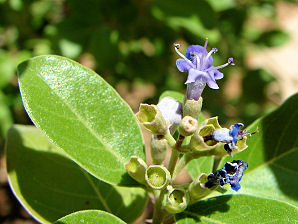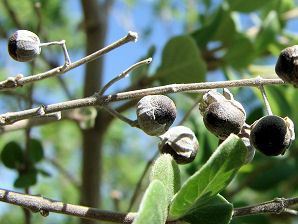Xeriscape Landscaping Plants For The Arizona Desert Environment.
Pictures, Photos, Information, Descriptions,
Images, & Reviews.
Trees.
Vitex Trees, Vitex mollis.
We Are Proud Of Our SafeSurf Rating!
Click On Any Of The Following Links By Amazon.Com
For Books, & Videos About Wildflowers Of Arizona & The Southwest USA. No Obligation!
 |
| Vitex Trees, Vitex mollis. Photos Taken At Mayo Clinic Scottsdale, Arizona. Sonoran Desert Nature Trail, May 5, 2008. |
|---|
 | |
| Vitex Trees. Vitex mollis. | Vitex Trees. Vitex mollis. |
|---|---|
 |  |
| Fruit. Vitex Trees. Vitex mollis. | Fruits. Vitex Trees. Vitex mollis. |
Vitex Tree.
We wish to thank Wikipedia, the free encyclopedia for some of the information on this page. We share images and information with Wikipedia. Vitex mollis is a small to medium, multistemmed, deciduous tree native of southern Sonora, & other states in central Mexico. Under uncultivated conditions the tree can become rather large. It is native of areas that are considered transitions between deserts and tropical regions. So, even though it grows at high elevations, that doesn't mean that it is cold hardy in the USA at that same elevation. Considered pool friendly. Also considered butterfly friendly.
Quick Notes:
Height: About 10 to 25 feet. Same spread. 36 to 60 feet tall in the wild.
Flowers: On purple spikes 7 to about 12 inches long, drooping from terminal portions of branches, appearing in the late spring and early summer.
Blooming Time: April - May.
Fruits: Fruits are about the size of an olive. Edible
Leaves: The leaves are soft, ovate, 2 4/5 to 4 inches long. Coriaceous and condulplicate.
Stems/Trunks: Dark blackish-brown with vertical ridges; multistemmed deciduous tree, sometimes single stemmed.
Found: Native of southern Sonora, Mexico into Central Mexico. A lot of research has been done at El Guayabo near Alamos, Sonora. Located at 1360 feet elevation, Alamos, is called the gateway to the tropics. We have been there in 1969.
Elevation: 1,300 to 6,000 feet native elevations.
Hardiness:
Soil pH requirements:
Sun Exposure:
Habitat: Sandy desert soils, hot, sunny areas, good drainage, to 3,800 feet.
Miscellaneous: Maintenance: Low. Flowering & Fruiting Photos Taken At Mayo Clinic Scottsdale, Nature Trail, May 5, 2008.
|
We Are Proud Of Our SafeSurf Rating!
Click On Any Of The Following Links By Amazon.Com
For Books, & Videos About Wildflowers Of Arizona & The Southwest USA. No Obligation!
| © 1966 - Present, Audrey, Eve, & George DeLange |
